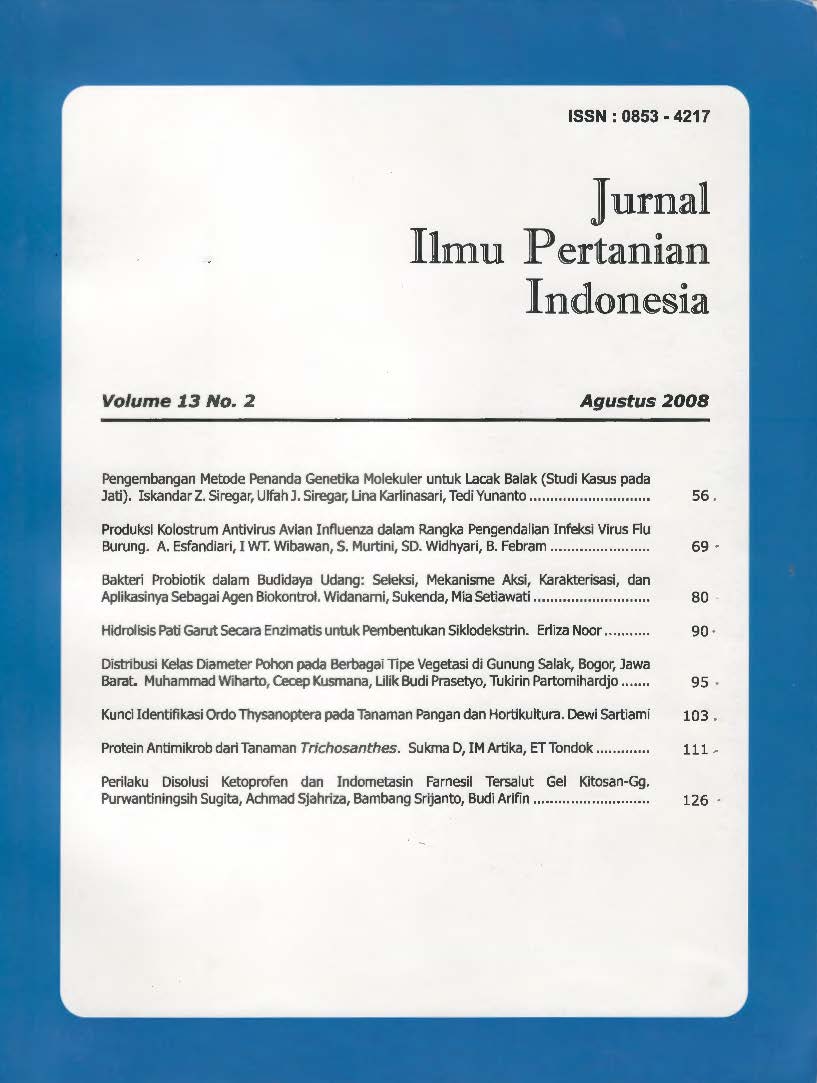Perilaku Disolusi Ketoprofen dan Indometasin Farnesil Tersalut Gel Kitosan-GG
Abstract
Chitosan, a modification of shrimp-shell waste, has been utilized as microcapsule. However, it's fragile gel property needs to be strengthened by adding glutaraldehyde (glu) and natural hydrocolloid guar gum (gg). This research's purposes were to determine rheological properties of chitosan-guar gum gel, to study diffusion and dissolution behaviour of ketoprofen and infar through optimum chitosan-guar gum gel membrane and microcapsule, respectively, and to test the coating stability of both medicines by the gel microcapsules, which are new drug's preparation, to determine their shelf lives and to predict the degradation mechanisms. This research was designed in six (6) steps: (1) chitin isolation and chitosan synthesis; (2) synthesis and optimization of chitosan-guar gum gel membrane; (3) in vitro study of ketoprofen and infar diffusion behaviour through the optimum membrane; (4) synthesis and optimization of chitosan-guar gum gel microcapsule to coat ketoprofen and infar; (5) in vitro study of ketoprofen and infar dissolution behaviour from the optimum microcapsule; and (6) physical and chemical microcapsule stability test using relative humidity (RH) and temperature controlled climatic chamber method. Studies on ketoprofen diffusion through chitosan-guar gum membrane showed that the formation of membrane small pores were appeared to be caused by membrane swelling, which was supported by the forcing force resulted from the difference of ketoprofen concentrations in the diffusion cells and from the temperature increase. This unique pore opening process is excellent for drug delivery process as a microcapsule. Spray drying process had successfully coated ketoprofen and infar in chitosan-guar gum microcapsule. Optimization by using Minitab Release 14 software showed that among the microcapsule compositions studied, [gg] and [glu] of 0.35% (w/v) and 3.75% (v/v), respectively were optimum to coat ketoprofen, whereas [gg] and [glu] of 0.05% (w/v) and 4.00% (v/v), respectively were optimum to coat infar, at constant chitosan concentration (1.75% [w/v]). In vitro dissolution profile showed that chitosan-guar gum gel microcapsule was more resistant in intestinal pH condition (rather basic) compared with that in gastric pH (very acidic). From stability test, formulation of ketoprofen preparation composed of 1.75% (w/v) chitosan, 0.35% (w/v) gg, and 3.50% (v/v) glu, was relatively the best, ·with ketoprofen percentage left in microcapsule after 3 months, degradation rate constant, and shelf life of of 80.33%, 0.0351 % week-1 and 18.92 months, respectively. The degradation of ketoprofen was seem to follow autocatalytic reaction mechanism controlled by the formation and growth of reaction core. In the other hand, the formulation with composition of 1.75% (w/v) chitosan, 0.19% (w/v) gg, and 5.00% (v/v) glu, was relatively the best microcapsule, with infar percentage left in microcapsule after 3 months, degradation rate constant, and shelf life of 77.67%, 0.0008 %-2 week-1 , and 4.28 week or about 30 days, respectively. The degradation of infar was presumably caused by hydrolysis.
Keywords: Chitosan-guar gum, diffusion, dissolution, stability
Downloads
This journal is published under the terms of the Creative Commons Attribution-NonCommercial 4.0 International License. Authors who publish with this journal agree to the following terms: Authors retain copyright and grant the journal right of first publication with the work simultaneously licensed under a Creative Commons Attribution-NonCommercial 4.0 International License. Attribution — You must give appropriate credit, provide a link to the license, and indicate if changes were made. You may do so in any reasonable manner, but not in any way that suggests the licensor endorses you or your use. NonCommercial — You may not use the material for commercial purposes.



















